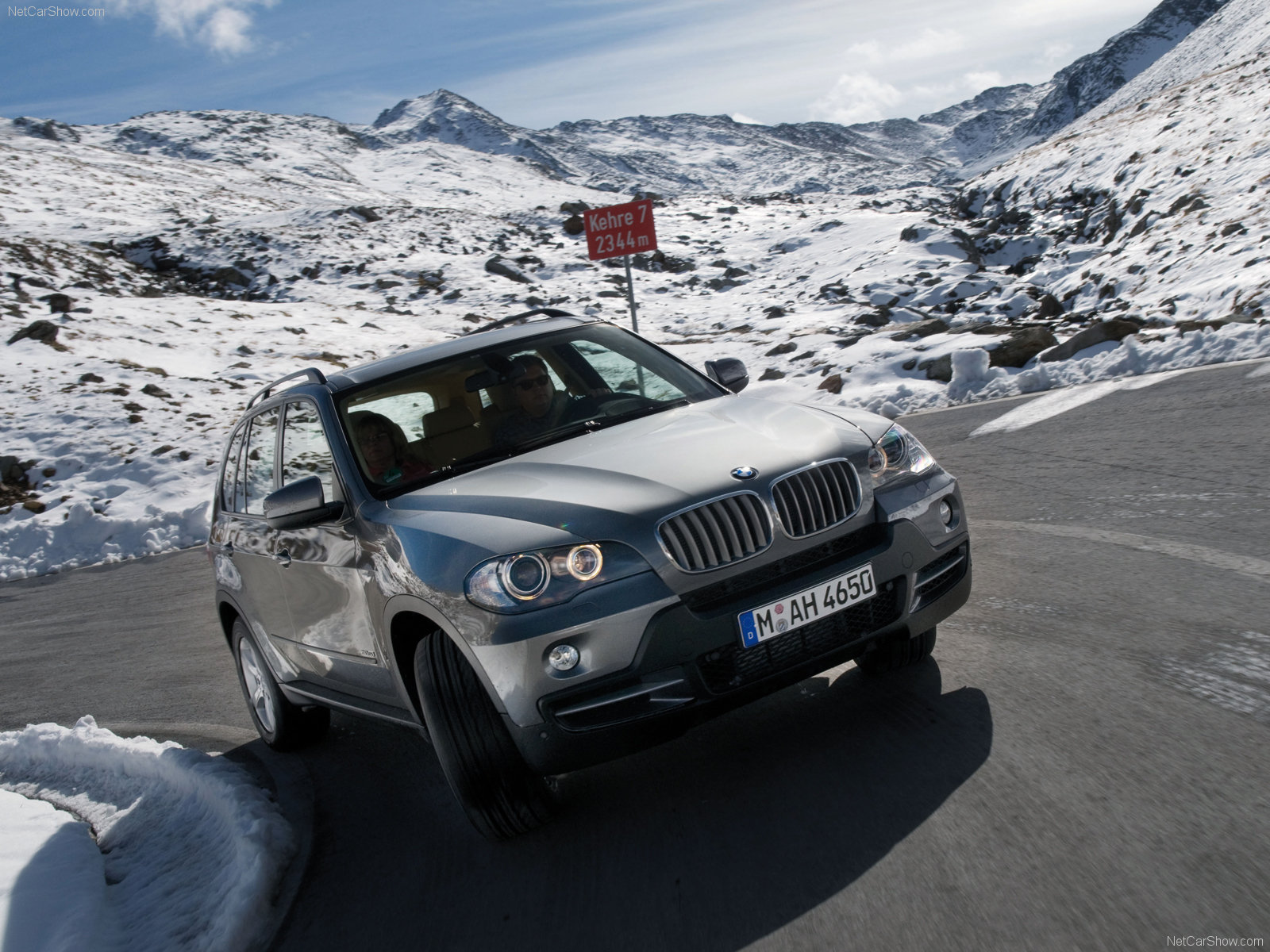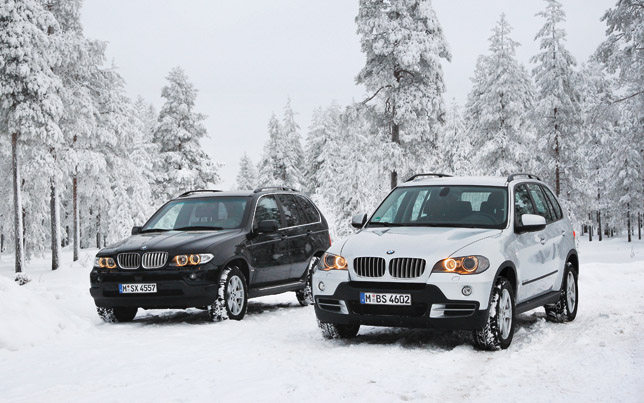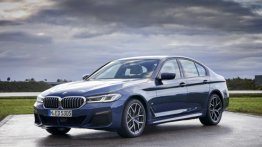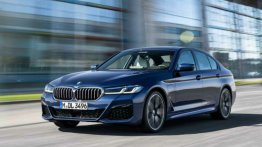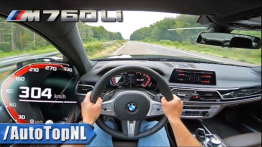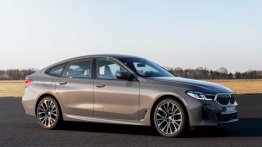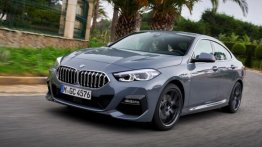The BMW X5, introduced in 1999 has been nothing short of a success story for BMW. Available in a choice of inline six and V8 engines, this Sports Activity model (SAV) emphasizes on on-road dynamics rather than a Sports Utility Vehicle (SUV).
In 2004, the model went through a makeover and by then, the X5 had gained popularity in India. Imports were plenty and it gained a reputation for a luxurious SUV. Indian sales stand very strong after BMW entered India and extended its service network.
The first model was penned by Chris Bangle at the California design studio and borrowed styling heavily from Range Rover (Which was then owned by BMW). Many of the Land Rover features were incorporated in the X5, notably the split-tailgate.
The 2004 facelift came with the X-Drive 4 wheel drive system with a rear-biased 62-38 torque split. xDrive could vary power to the front or rear axles in milliseconds, transferring up to 100% of engine power to either axle, thus allowing the vehicle to regain traction quickly.
Year 2007 saw the thorough revision and the E70 2nd gen X5 came into existence (One that you see in the picture).
Press Release
With superior dynamic performance on the road and outstanding traction on rough terrain, the BMW X5 has been on an unstoppable course for success for ten years. BMW presented the first generation of the all-wheel-drive five-door vehicle at the North American International Auto Show in 1999, thereby founding the segment of the Sports Activity Vehicle (SAV).
The world premiere marked the start of an unprecedented success story. Within one decade, over 845,000 units of the BMW X5 were sold. As a result of the consistent further development of the SAV concept, there are now three BMW X models to choose from, with a fourth ready for serial production in 2009. What is more, the BMW X5 became the key inspiration for the entire competitive field of all-wheel-drive vehicles. In its anniversary year, with the BMW X5 now in its second generation, the vehicle remains the role model and benchmark of its class in terms of driving dynamics, efficiency, versatility, premium quality and safety.
From the very beginning, the key to the success of the BMW X5 lay in its combination of two fascinating qualities which had never been realised in any vehicle previously. The new model successfully transferred characteristic BMW driving pleasure into a completely new market segment. For the very first time, the spacious, permanently four-wheel driven BMW X5 combined the driving dynamics of a BMW sedan with supreme mobility away from asphalted road surfaces. Its integral safety body and independent wheel suspension clearly set the BMW X5 apart from conventional off-road vehicles, with the driving stability system DSC (Dynamic Stability Control) including automatic differential brake ADB-X (Automatic Differential Brake) and HDC (Hill Descent Control) ensuring supreme driving qualities both on and off the road.
Dynamic performance and versatility were also expressed in the design of the vehicle. Another striking feature was the raised seating position which instantly gave the driver the same sense of supremacy which was provided by the chassis technology. In addition, the spacious, versatile and high-quality interior provided a whole new driving experience for an all-wheel-drive automobile.
The second generation of the BMW X5 launched in autumn 2006 saw a consistent further development of the Sports Activity Vehicle’s characteristic features. With its increased space comfort, luxurious ambience, even more supreme drivetrain technology and innovative chassis along with driver assistance systems, the new BMW X5 once again sets the benchmark throughout the extended competitive field of BMW X models. Like its predecessor it is produced at BMW’s North American plant in Spartanburg and is the first BMW to potentially provide seating for up to seven occupants. Its further developed intelligent all-wheel drive BMW xDrive uniquely enhances both driving dynamics on the road and traction over rough terrain. The permanent, electronically controlled all-wheel drive, which is also networked with the drive stability system DSC, distributes drive power variably between the front and rear wheels.
With the success of the BMW X5, the foundation stone was laid for the current status of BMW as the world’s most successful manufacturer of premium all-wheel drive vehicles. What is more, numerous reputable awards for the vehicle’s design, quality and safety reflect the increased appeal of the large SAV models made by BMW. In 2007 the BMW X5 received the design award “autonis” of the automobile journal “auto motor und sport” for the most attractive design and a gold award in the J.D. Power customer satisfaction study in North America, as well as securing class victory in the “auto 1” competition of the international “Auto Bild” Group. These prizes were followed in 2008 by class victory in the “auto, motor und sport” readers’ vote “The best cars”. Twice in succession, the BMW X5 also won a place among the three vehicles with the most stable value in the German automobile market, causing the magazine “Auto Bild” to pronounce it “Value Master of the Year” in both 2007 and 2008.
As long ago as 2000, the Insurance Institute for Highway Safety (IIHS) in the US declared the BMW X5 of the first generation to be the safest vehicle ever to be subjected to one of its crash tests. In 2003 the SAV achieved the highest possible score of 5 stars on the Euro-NCAP crash test. The current BMW X5 received the “Top Safety Pick Award” for outstanding crash test results from the IIHS in both 2007 and 2008.
The BMW X5 of model year 2009 also occupies a leading position in the area of efficiency. State-of-the-art 8 and 6-cylinder petrol engines and outstandingly economical 6-cylinder diesel engines in combination with current BMW EfficientDynamics measures ensure that the BMW X5 combines its excellent qualities with fuel consumption and exhaust emission levels which are exemplary in its vehicle and output category. This is also evidence that the development strategy BMW EfficientDynamics has taken impressive effect in the segment of the BMW X models, too. After all, the fuel consumption of all engine types of the BMW X5 has been considerably reduced in the course of its ten-year history – despite a significant increase in power. The BMW X5 xDrive48i of model year 2009 achieves an average fuel consumption of 12.1 litres per 100 kilometres in the EU test cycle – 13 per cent lower than the BMW X5 4.4i of the year 2000 which had almost 70 bhp less output. The BMW X5 xDrive30i surpasses its predecessor models by 41 bhp, yet it has an average fuel consumption level of just 10.3 litres per 100 kilometres, i.e. around 20 per cent less. In the BMW X5 xDrive30d, the output has been increased by 51 bhp, but fuel consumption has been cut by over 15 per cent to 8.2 litres per 100 kilometres.
These figures are all the more impressive when they are viewed in relation to the space and comfort offered by the vehicle. The first BMW to offer space for seven vehicle occupants is available with engines which offer outstanding fuel economy and a low level of exhaust emissions. With an average fuel consumption of 8.2 litres per 100 kilometres and a CO2 output of 217 grams the BMW X5 xDrive30d with 173 kW/235 bhp shows a remarkable degree of efficiency, especially considering its seating capacity: even in the segment of small cars, a per-capita fuel consumption of less than 1.2 litres per 100 kilometres and the relevant CO2 output level of 31 grams per kilometre is achieved only rarely.
